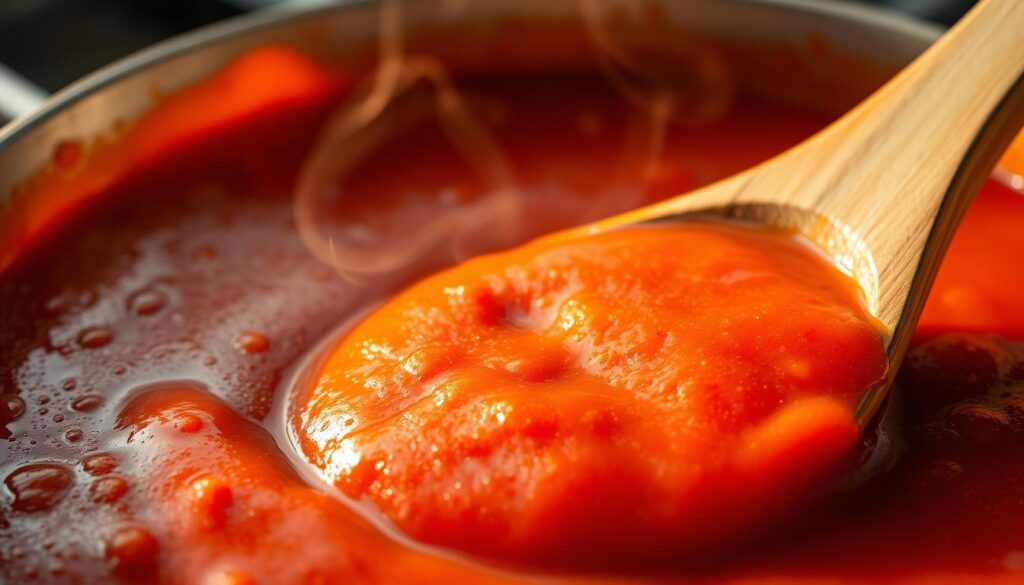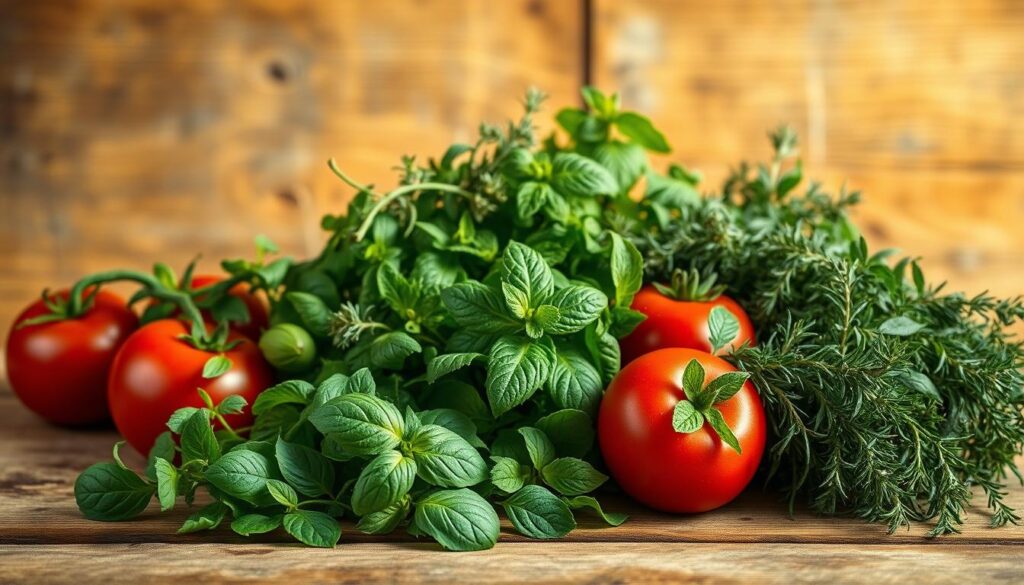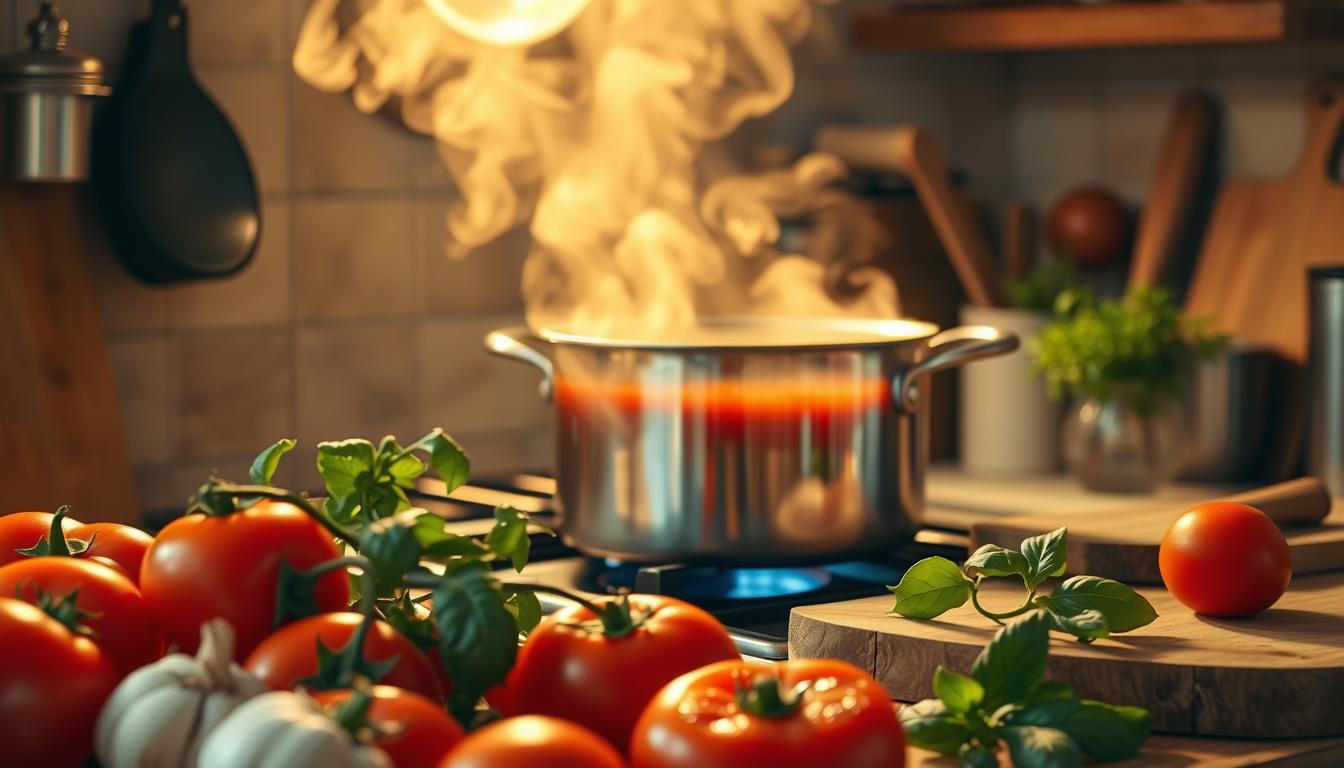Every kitchen has its special moment. It’s when simple ingredients become something amazing. For me, making the perfect homemade pomodoro sauce is a journey of passion and precision.
Pomodoro sauce is more than a recipe. It’s a way to connect with Italian cuisine through its simple yet vibrant flavors. Whether you’re new to cooking or have years of experience, mastering this sauce will take your cooking to new heights.
Making a great homemade pomodoro sauce isn’t hard. It’s about understanding the heart of Italian cooking. You’ll discover how to turn basic ingredients into a sauce that’s rich, smooth, and full of tomato flavor.
In this guide, we’ll cover seven key techniques for making the best pomodoro sauce every time. Get ready to improve your cooking and wow your family and friends.
Understanding the Classic Italian Pomodoro Sauce
Explore the world of authentic pomodoro sauce, a favorite among food lovers everywhere. This traditional recipe is more than a tomato sauce. It shows the beauty of Italian cooking’s simplicity and elegance.
Origin and Meaning of Pomodoro
The word pomodoro means “golden apple” in Italian, showing the bright color of ripe tomatoes. It started in Southern Italy after tomatoes came from the Americas in the 16th century. It quickly became a key part of traditional cooking.
- Derived from Italian words “pomo” (apple) and “d’oro” (gold)
- Became popular in the late 19th century
- Represents the essence of Italian home cooking
Difference Between Pomodoro and Marinara
Pomodoro and marinara are often mixed up, but they’re not the same. Pomodoro sauce is smoother and has a richer tomato taste.
| Characteristic | Pomodoro Sauce | Marinara Sauce |
|---|---|---|
| Texture | Smooth and thick | Chunky and lighter |
| Cooking Time | Longer reduction | Shorter cooking process |
Why This Sauce Became a Classic
The traditional pomodoro sauce recipe is loved for its versatility. It turns simple ingredients into a rich sauce. This sauce is great with pasta, as a base for other dishes, and shows the heart of Italian cooking.
“Simplicity is the ultimate sophistication” – Leonardo da Vinci
Whether you’re a chef or a home cook, learning to make authentic pomodoro sauce is a tasty journey into Italian cuisine.
Essential Ingredients for Authentic Pomodoro Sauce
Making the best pomodoro sauce starts with knowing its key ingredients. The classic version is a mix of simple, high-quality parts. These parts turn regular meals into unforgettable dishes.
To make a real classic pomodoro sauce, start by picking top-notch ingredients. The base of a great sauce is its main parts:
- Tomatoes: The heart of your best pomodoro sauce (fresh or canned)
- Extra virgin olive oil
- Fresh garlic
- Optional sweet onions
- Fresh basil leaves
- High-quality sea salt
- Fresh ground black pepper
Every ingredient is important for the sauce’s rich taste. Extra virgin olive oil gives a smooth base that brings out the tomatoes’ sweetness. Garlic adds a strong flavor, and fresh basil adds a bright, aromatic note that makes the sauce stand out.
When picking ingredients for your classic pomodoro sauce, choose fresh and high-quality ones. Good tomatoes and olive oil can make a simple sauce into a memorable dish.
“The secret to an exceptional pomodoro sauce lies not in complexity, but in the quality of its ingredients.”
Selecting the Perfect Tomatoes for Your Sauce
Making a tasty pomodoro sauce begins with picking the right tomatoes. The quality of your tomatoes can turn a simple meal into a work of art.
Choosing tomatoes is an art that needs thought. The taste, texture, and quality of your sauce depend on the tomatoes you pick.
Fresh vs. Canned Tomatoes
Deciding between fresh or canned tomatoes is key. Both have their good points:
- Fresh tomatoes add a burst of flavor in summer
- Canned tomatoes offer consistent taste all year
- What’s in season affects your sauce’s flavor
Why San Marzano Tomatoes Matter
San Marzano tomatoes are the top choice for a great pomodoro sauce. They add sweetness and less acidity to your sauce.
| Tomato Type | Flavor Profile | Best Use |
|---|---|---|
| San Marzano | Sweet, Low Acid | Premium Sauces |
| Roma | Mild, Meaty | Everyday Cooking |
| Beefsteak | Rich, Juicy | Fresh Preparations |
Seasonal Considerations
Choose tomatoes that match the season. Summer is the best time for fresh tomatoes. In winter, high-quality canned tomatoes are a good choice. Always go for flavor and ripeness.
Pro tip: If fresh tomatoes aren’t perfect, use premium canned San Marzano tomatoes. They make a delicious, authentic pomodoro sauce.
The Secret to Perfect Pomodoro Sauce Consistency

Making the perfect pomodoro sauce is an art. It turns a simple recipe into a masterpiece. The secret is knowing how cooking time and temperature create the perfect texture.
To make a great homemade pomodoro sauce, focus on three key things:
- Reduction technique: Slow cooking makes the sauce thicker
- Control the temperature
- Manage the liquid well
Getting the sauce just right takes patience. Start by cooking your tomatoes at a low simmer. This helps concentrate the flavors without burning. You want a sauce that sticks to the back of a spoon, not too thin or too thick.
“A great pomodoro sauce should have body and depth, clinging gracefully to your pasta.” – Italian Cooking Tradition
Here are some tips for keeping your sauce at the right consistency:
- Choose ripe, meaty tomatoes
- Strain off excess liquid before cooking
- Add a bit of tomato paste if it’s too thin
- Stir now and then to stop it from sticking
Remember, the more you make it, the better you’ll get. Your homemade pomodoro sauce will get better with each try as you learn to adjust the texture.
Step-by-Step Cooking Method
Making a traditional pomodoro sauce recipe needs precision and care. The cooking method is key to getting rich, deep flavors. These flavors make the sauce a true culinary masterpiece.
Preparation Phase
Before cooking, gather all your ingredients and prepare them carefully. The best pomodoro sauce comes from the details:
- Finely chop fresh onions and garlic
- Measure out high-quality olive oil
- Select ripe, fresh tomatoes or premium canned tomatoes
- Prepare fresh herbs like basil and oregano
Precise Cooking Techniques
The traditional pomodoro sauce recipe needs specific cooking techniques for maximum flavor:
- Heat olive oil in a heavy-bottomed pan over low heat
- Sauté onions and garlic until translucent (about 5-7 minutes)
- Add tomatoes and crush them gently
- Simmer on low heat to develop deep flavors
Timing and Temperature Control
| Cooking Stage | Temperature | Duration |
|---|---|---|
| Sautéing Aromatics | Low Heat | 5-7 minutes |
| Simmering Sauce | Low-Medium Heat | 30-45 minutes |
| Final Seasoning | Low Heat | 5 minutes |
Pro tip: Patience is the secret to perfect pomodoro sauce. Cooking slowly lets flavors blend well. This turns simple ingredients into a spectacular sauce.
Herbs and Seasonings That Enhance Your Sauce

Making an authentic pomodoro sauce is more than just tomatoes. The right herbs and seasonings can make a great sauce even better. It will impress anyone who loves Italian food.
Fresh herbs are key to improving your sauce’s taste. A few important ingredients add depth and complexity:
- Basil: The heart of traditional pomodoro sauce, with a sweet and peppery taste
- Oregano: Adds a slightly bitter, earthy flavor
- Thyme: Brings a subtle, minty taste
- Parsley: Adds a fresh, light touch to the sauce
Seasoning is vital for a true pomodoro sauce. Salt and pepper are not just extras. They balance and highlight the tomato’s sweetness. Start with a little, then taste and adjust.
“The beauty of a perfect pomodoro sauce lies in its simplicity and the careful balance of herbs and seasonings.” – Italian Cooking Masters
For a bit of heat, red pepper flakes can be added. But remember, the goal is to enhance the tomatoes, not take over.
Pro tip: Add fresh herbs at the end of cooking. This keeps their flavor and aroma bright and fresh.
Common Mistakes to Avoid When Making Pomodoro Sauce
Making perfect easy pomodoro sauce needs skill and focus. Even skilled cooks can make mistakes. Knowing these common errors helps you make a great sauce every time.
Mastering pomodoro sauce is more than just following a recipe. It’s about knowing the small details that can make your dish stand out.
Temperature Troubles That Can Ruin Your Sauce
- Cooking at too high heat can cause burning
- Rapid boiling destroys delicate tomato flavors
- Uneven heat distribution leads to inconsistent texture
Seasoning Mistakes to Watch Out For
Seasoning can turn a simple sauce into a masterpiece. Here are some common mistakes to avoid:
- Under-seasoning makes the sauce taste flat
- Over-salting can make the sauce inedible
- Adding herbs at the wrong time diminishes their flavor
Texture Problems That Impact Your Sauce
The perfect sauce should be smooth and rich. Watch out for these texture issues:
- Watery sauce indicates insufficient reduction
- Overly chunky texture suggests improper blending
- Grainy consistency means poor ingredient selection
Pro tip: Patience is key when making pomodoro sauce. Low and slow cooking helps develop deep, rich flavors and prevents common mistakes.
Storage and Make-Ahead Tips
Keeping your homemade pomodoro sauce fresh is key. The right storage methods make it a great meal prep option. It saves you time in the kitchen.
Proper refrigeration is essential for your sauce’s quality. Here are some important storage tips:
- Cool the sauce completely before storing
- Use airtight glass or plastic containers
- Store in the refrigerator for up to 7 days
- Label containers with the preparation date
Freezing your sauce extends its shelf life. Freezing is great for saving large batches:
- Let the sauce cool to room temperature
- Pour into freezer-safe containers
- Leave about 1/2 inch of space at the top for expansion
- Freeze for up to 3 months
“A well-preserved sauce is like a culinary time capsule, capturing the essence of fresh ingredients.” – Italian Cooking Wisdom
Pro tip: The flavor of your sauce gets better after a day or two in the fridge. The ingredients blend, making the taste richer. To use, thaw frozen sauce in the fridge overnight. Then, reheat it gently on the stovetop.
Mastering these storage tips means you’ll always have delicious, fresh sauce. It’s perfect for enhancing your favorite Italian dishes.
Serving Suggestions and Pairing Ideas
Your delicious pomodoro sauce makes any meal special. It’s perfect for more than just pasta. Try it with different dishes to see how it can change your meals.
Classic pasta is a great match for your homemade sauce. Here are some pasta shapes that go well with the sauce:
- Spaghetti
- Penne
- Rigatoni
- Linguine
But your sauce is good for more than pasta. Here are some other ways to use it:
- Use as a pizza base
- Serve with grilled proteins
- Create vegetarian dishes
- Utilize as a dipping sauce
| Protein Pairing | Recommended Preparation |
|---|---|
| Chicken | Baked Parmesan-style |
| Salmon | Grilled with herb crust |
| Shrimp | Garlic rosemary broiled |
For vegetarian dishes, try it with zucchini noodles, gnocchi, or on roasted veggies. It’s a great way to make a tasty meal.
Pro tip: Add fresh basil leaves and grated Parmesan cheese. It brings out the sauce’s true Italian taste.
Conclusion
Making authentic pomodoro sauce is more than cooking—it’s an art that connects you to Italy’s rich culinary traditions. By following the steps we’ve shared, you can turn simple ingredients into a vibrant sauce. This sauce will make any pasta dish better.
Creating the best pomodoro sauce takes patience, practice, and passion. Every time you make it, you’ll get better and appreciate its simplicity and flavor more. Great cooking is about trying new things and learning from each experience.
Your dedication to using top-notch ingredients and mastering cooking techniques will make your sauce stand out. Whether you’re cooking at home or dreaming of being a chef, these tips will help you make a sauce that truly captures the spirit of Italian cuisine.
We encourage you to share your pomodoro sauce stories and how you’ve made it your own. Every cook adds their own twist to this classic recipe. Your story could inspire others to dive into the world of Italian cooking.

